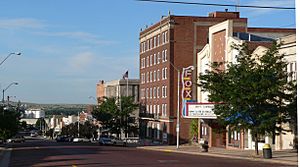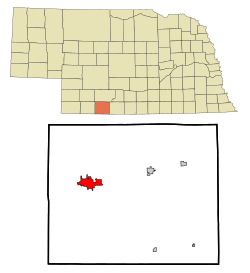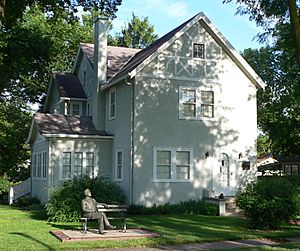McCook, Nebraska facts for kids
Quick facts for kids
McCook, Nebraska
|
|
|---|---|

George Norris Avenue
|
|

Location of McCook within Nebraska and Red Willow County
|
|
| Country | United States |
| State | Nebraska |
| County | Red Willow |
| Area | |
| • Total | 5.40 sq mi (13.98 km2) |
| • Land | 5.40 sq mi (13.98 km2) |
| • Water | 0.00 sq mi (0.00 km2) |
| Elevation | 2,572 ft (784 m) |
| Population
(2010)
|
|
| • Total | 7,698 |
| • Estimate
(2019)
|
7,560 |
| • Density | 1,400.52/sq mi (540.74/km2) |
| Time zone | UTC−6 (Central (CST)) |
| • Summer (DST) | UTC−5 (CDT) |
| ZIP code |
69001
|
| Area code(s) | 308 |
| FIPS code | 31-29925 |
| GNIS feature ID | 0831117 |
| Website | cityofmccook.com |
McCook is a city in and the county seat of Red Willow County, Nebraska, United States. The population was 7,698 at the 2010 census.
Contents
History
McCook was platted in 1882 when the Burlington and Missouri River Railroad was extended to that point. It was named in honor of Alexander McDowell McCook, a Brigadier General in the Union Army during the American Civil War.
Geography
McCook is located at 40°12′19″N 100°37′34″W / 40.20528°N 100.62611°W (40.205228, −100.626174). According to the United States Census Bureau, the city has a total area of 5.39 square miles (13.96 km2), all of it land.
Climate
McCook's climate is formally classified as hot-summer humid continental. Due to the very hot and humid summers typical of the Midwest and the January daily mean averaging around −3 °C (27 °F) (the isotherm for being continental) it has significant influence of the humid subtropical climate, lying in the transition zone between the climate types. Winters are generally dry and summers wet.
| Climate data for McCook | |||||||||||||
|---|---|---|---|---|---|---|---|---|---|---|---|---|---|
| Month | Jan | Feb | Mar | Apr | May | Jun | Jul | Aug | Sep | Oct | Nov | Dec | Year |
| Record high °C (°F) | 25 (77) |
28 (82) |
33 (91) |
36 (97) |
40 (104) |
44 (111) |
45 (113) |
43 (109) |
41 (106) |
36 (97) |
30 (86) |
25 (77) |
45 (113) |
| Average high °C (°F) | 4.8 (40.6) |
7 (45) |
12.3 (54.1) |
18.1 (64.6) |
23 (73) |
28.9 (84.0) |
32.2 (90.0) |
30.9 (87.6) |
26.3 (79.3) |
19.2 (66.6) |
11.3 (52.3) |
5 (41) |
18.3 (64.9) |
| Daily mean °C (°F) | −2.7 (27.1) |
−0.6 (30.9) |
4.1 (39.4) |
9.7 (49.5) |
15.3 (59.5) |
21.1 (70.0) |
24.4 (75.9) |
23.2 (73.8) |
18 (64) |
10.7 (51.3) |
3.4 (38.1) |
−2.2 (28.0) |
10.4 (50.7) |
| Average low °C (°F) | −10.1 (13.8) |
−8.3 (17.1) |
−4.1 (24.6) |
1.3 (34.3) |
7.7 (45.9) |
13.3 (55.9) |
16.6 (61.9) |
15.5 (59.9) |
9.6 (49.3) |
2.3 (36.1) |
−4.4 (24.1) |
−9.4 (15.1) |
2.6 (36.7) |
| Record low °C (°F) | −34 (−29) |
−38 (−36) |
−28 (−18) |
— | −10 (14) |
1 (34) |
6 (43) |
3 (37) |
−5 (23) |
−18 (0) |
−23 (−9) |
−31 (−24) |
−38 (−36) |
| Average rainfall mm (inches) | 12.7 (0.50) |
15.2 (0.60) |
35.6 (1.40) |
58.4 (2.30) |
78.7 (3.10) |
86.4 (3.40) |
83.8 (3.30) |
78.7 (3.10) |
35.6 (1.40) |
45.7 (1.80) |
25.4 (1.00) |
15.2 (0.60) |
571.5 (22.50) |
Demographics
| Historical population | |||
|---|---|---|---|
| Census | Pop. | %± | |
| 1890 | 2,346 | — | |
| 1900 | 2,445 | 4.2% | |
| 1910 | 3,765 | 54.0% | |
| 1920 | 4,303 | 14.3% | |
| 1930 | 6,688 | 55.4% | |
| 1940 | 6,212 | −7.1% | |
| 1950 | 7,678 | 23.6% | |
| 1960 | 8,301 | 8.1% | |
| 1970 | 8,285 | −0.2% | |
| 1980 | 8,404 | 1.4% | |
| 1990 | 8,112 | −3.5% | |
| 2000 | 7,994 | −1.5% | |
| 2010 | 7,698 | −3.7% | |
| 2019 (est.) | 7,560 | −1.8% | |
| U.S. Decennial Census 2012 Estimate |
|||
2010 census
As of the census of 2010, there were 7,698 people, 3,324 households, and 2,021 families living in the city. The population density was 1,428.2 inhabitants per square mile (551.4/km2). There were 3,717 housing units at an average density of 689.6 per square mile (266.3/km2). The racial makeup of the city was 95.8% White, 0.5% African American, 0.5% Native American, 0.4% Asian, 1.5% from other races, and 1.3% from two or more races. Hispanic or Latino of any race were 4.9% of the population.
There were 3,324 households, of which 27.4% had children under the age of 18 living with them, 47.8% were married couples living together, 9.3% had a female householder with no husband present, 3.7% had a male householder with no wife present, and 39.2% were non-families. 33.9% of all households were made up of individuals, and 16.7% had someone living alone who was 65 years of age or older. The average household size was 2.25 and the average family size was 2.89.
The median age in the city was 40.7 years. 23% of residents were under the age of 18; 9.4% were between the ages of 18 and 24; 22% were from 25 to 44; 26.2% were from 45 to 64; and 19.5% were 65 years of age or older. The gender makeup of the city was 48.3% male and 51.7% female.
Culture
The Harvey P. Sutton House at 602 Norris Avenue was designed by influential architect Frank Lloyd Wright in 1905–1907 and built 1907–1908. The classic Prairie-style house is listed in the National Register of Historic Places; it is the only Wright house known to have been built in Nebraska. The house is used as a private residence, and is not open to the public.
McCook hosts the Buffalo Commons Storytelling Festival each summer. There is also the Heritage Day Celebration and the McCook Balloon Fest in September.
McCook Army Airfield, active from 1943 through 1945, was located nine miles northwest of McCook.
McCook hosted a professional baseball team, the McCook Braves, who played in the Nebraska State League from 1956–59. In their final season in 1959, the club featured future Baseball Hall of Famer Phil Niekro and won the NSL championship; both the Braves and the league folded at season's end. Another pitcher on the team, Pat Jordan, later became a writer for the Sporting News, and wrote an autobiography dealing with his career with the Braves, A False Spring.
McCook is home to the first 2-year Junior College in Nebraska, it was founded in September of 1926 on the second floor of the YMCA building on Main Street. The name was eventually changed to McCook Community College and and was governed over the Mid-Plains Area.
Transportation
Rail
Amtrak, the national passenger rail system, provides service through McCook, operating its California Zephyr daily in both directions between Chicago and Emeryville (Oakland), California, with stops in Omaha, Lincoln, and Hastings.
Air
Commuter airline Boutique Air is currently serving the McCook Regional Airport with daily nonstop round trip commercial flights to Denver, Colorado.
Notable people
George W. Norris, who held seats in the U.S. House of Representatives and Senate from 1903 to 1943, was a resident of McCook. Norris was the driving force behind the conversion of Nebraska's legislature to a unicameral system; in the Senate, he was a leading figure behind the creation of the Tennessee Valley Authority. His house in McCook is operated as a museum by the Nebraska State Historical Society, and is listed in the National Register of Historic Places. Originally named Main, the principal north–south thoroughfare through central McCook was renamed Norris Avenue in his honor.
Three governors of Nebraska made their homes in McCook: Ralph G. Brooks, Frank Morrison, and Ben Nelson, who represented Nebraska in the U.S. Senate for two terms, from 2000 to 2012. Frank B. Morrison Jr., Montana Supreme Court justice and son of Frank Morrison, was born in McCook.
John R. McCarl, the first Comptroller General of the United States, was raised in McCook. He is also buried there.
Former professional football player Jeff Kinney is a 1968 graduate of McCook High School.
TV evangelist Bob Larson was raised in McCook.
See also
 In Spanish: McCook (Nebraska) para niños
In Spanish: McCook (Nebraska) para niños


